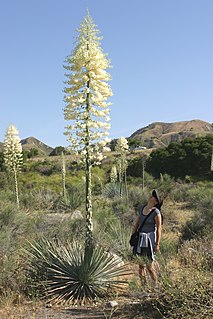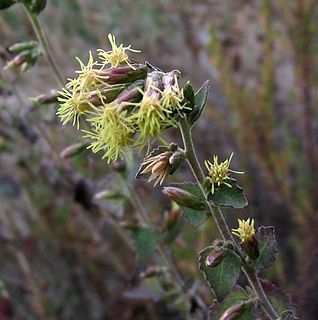
Ragweeds are flowering plants in the genus Ambrosia in the aster family, Asteraceae. They are distributed in the tropical and subtropical regions of the Americas, especially North America, where the origin and center of diversity of the genus are in the southwestern United States and northwestern Mexico. Several species have been introduced to the Old World and some have naturalized and have become invasive species. Ragweed species are expected to continue spreading across Europe in the near future in response to ongoing climate change.

Palafoxia, or palafox, is a genus of North American flowering plants in the Bahia tribe within the Asteraceae.

Hesperoyucca whipplei, the chaparral yucca, our Lord's candle, Spanish bayonet, Quixote yucca or foothill yucca, is a species of flowering plant closely related to, and formerly usually included in, the genus Yucca. It is native to southern California, United States and Baja California, Mexico, where it occurs mainly in chaparral, coastal sage scrub, and oak woodland plant communities at altitudes of 0–2500 m.

Rubus leucodermis, also called whitebark raspberry or blackcap raspberry, is a species of Rubus native to western North America, from Alaska southward along the Pacific coast as far as California, Arizona, New Mexico, and Chihuahua.

Ambrosia dumosa, the burro-weed or white bursage, a North American species of plants in the family Asteraceae. It is a common constituent of the creosote-bush scrub community throughout the Mojave desert of California, Nevada, and Utah and the Sonoran Desert of Arizona and northwestern Mexico.

Encelia virginensis is a North American species of flowering plants in the family Asteraceae known by the common name Virgin River brittlebush. This shrub is native to the southwestern United States and northwestern Mexico, particularly the Mojave Desert and the Sonoran Desert. It has been found in Baja California, southern California, Nevada, Arizona, southwestern Utah, and southwestern New Mexico.

Lycium andersonii is a species of flowering plant in the nightshade family, Solanaceae. Its common names include water-jacket, redberry desert-thorn, Anderson thornbush, Anderson's desert thorn, Anderson boxthorn, Anderson lycium, Anderson wolfberry, and squawberry.

Senecio flaccidus, formerly recorded as Senecio douglasii, member of the daisy family and genus Senecio also known as threadleaf ragwort, is a native of the southwestern Great Plains of North America.

Calycoseris wrightii, commonly known as white tackstem, is an annual spring wildflower, one of two species in the genus Calycoseris; the other species is C. parryi, the yellow tackstem. They are part of the family Asteraceae.

Brickellia californica, known by the common name California brickellbush, is a species of flowering plant in the family Asteraceae.

Adenophyllum porophylloides is a species of flowering plant in the family Asteraceae known by the common names San Felipe dogweed and San Felipe dyssodia. It is native to the Sonoran and Mojave Deserts of the southwestern United States and northwestern Mexico.

Ageratina herbacea is a North American species of flowering plants in the family Asteraceae known by the common names fragrant snakeroot and Apache snakeroot. It is native to desert regions of the southwestern United States and northern Mexico. It grows in rocky slopes in conifer forests and woodlands.

Ambrosia chenopodiifolia is a species of ragweed known by the common names San Diego bursage and San Diego bur ragweed. It is native to the Mexican states of Baja California and Baja California Sur, as well as to Orange and San Diego Counties it int US State of California. It is a member of the coastal sage scrub plant community.

Ambrosia pumila is a rare species of herbaceous perennial plant known by the common names San Diego ragweed and San Diego ambrosia. It is native to far southern California, Baja California, and Baja California Sur. It grows in floodplains and open grasslands in proximity to wetland areas.

Quercus turbinella is a North American species of oak known by the common names shrub oak, turbinella oak, shrub live oak, and gray oak. It is native to Arizona, California, New Mexico, Utah, Colorado, and Nevada in the western United States. It also occurs in northern Mexico.

Ambrosia salsola, commonly called cheesebush, winged ragweed, burrobush, white burrobrush, and desert pearl, is a species of perennial shrub in the family Asteraceae native to deserts of the southwestern United States and northwestern Mexico.

Brickellia microphylla, the littleleaf brickellbush, is a flowering plant species in the family Asteraceae native to western North America.

Centromadia pungens, the common spikeweed or common tarweed, is a species of North American plants in the tribe Madieae within the family Asteraceae. It is native to northern Baja California and the western United States. The plant is considered a noxious weed in parts of the Pacific Northwest.

Centromadia parryi, the pappose tarweed, is a species of plant in the tribe Madieae within the family Asteraceae. It is found in North America where it is native to California and, northern Baja California.

Ericameria palmeri is a North American species of flowering shrubs in the daisy family. It is native to southern California in the United States and to the state of Baja California in Mexico.




















